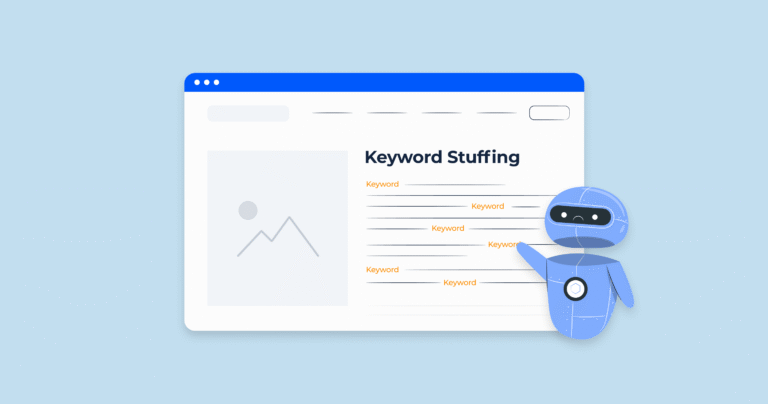In the world of digital marketing, mastering SEO techniques can make or break your online success. At Seo Khana, we’ve seen many businesses struggle with outdated tactics like keyword stuffing—overloading content with the same keywords in an attempt to boost rankings. Not only does this practice hurt your site’s visibility, but it also damages user experience and can lead to penalties from search engines like Google.
This article will help you understand what keyword stuffing is, why it’s harmful, and most importantly, how to avoid keyword stuffing while still optimizing your content effectively. With Seo Khana’s expert guidance, you’ll learn to create SEO-friendly content that ranks higher naturally, attracts real visitors, and builds lasting credibility for your brand.
What Is Keyword Stuffing?
Keyword stuffing is an outdated SEO technique where a webpage is filled with a specific keyword or phrase too frequently in an unnatural way. The purpose behind this tactic was to manipulate search engine algorithms and increase a page’s ranking for that keyword. In the early days of SEO, this method was somewhat effective, but search engines have since evolved to detect and penalize such practices.
Today, keyword stuffing is considered a black-hat SEO strategy that goes against Google’s quality guidelines. It often results in content that is difficult to read, repetitive, and unhelpful to users. For example, using the same keyword five or six times in one sentence—or placing a long list of keywords at the bottom of a page—are signs of keyword stuffing. This approach can lead to lower engagement, higher bounce rates, and even penalties that reduce a site’s visibility in search results.
Modern SEO emphasizes high-quality, relevant content that addresses the user’s search intent. Instead of keyword stuffing, content creators should focus on writing naturally and using a variety of related keywords or phrases. Tools like a keyword stuffing checker can help ensure content maintains a healthy balance. Ultimately, avoiding keyword stuffing is crucial for building trust with both users and search engines.
Why Keyword Stuffing Is Bad for SEO
Keyword stuffing is an outdated SEO tactic that can seriously harm your website’s rankings and user experience. Below are the main reasons why keyword stuffing is bad for SEO and should be avoided.
Violates Google’s Guidelines
- Google considers keyword stuffing a spammy and manipulative practice.
- It can lead to penalties or removal from search results.
Creates Poor User Experience
- Repetitive and unnatural content makes it hard to read.
- Visitors may leave the page quickly, increasing bounce rates.
Hurts Content Quality
- Stuffed content lacks flow, clarity, and relevance.
- Readers may not find the answers they are looking for.
Damages SEO Performance
- Search engines prioritize high-quality, user-friendly content.
- Keyword stuffing can prevent your page from ranking well.
Affects Brand Trust
- Users can sense when content is written for search engines, not for them.
- This can reduce trust and harm your brand image.
Wastes Marketing Efforts
- Time spent stuffing keywords could be used to create valuable, engaging content.
- Bad SEO practices weaken your overall digital marketing strategy.

learn more about short tail keywords and keyword intent
How to Avoid Keyword Stuffing
- Write naturally: Focus on creating content that reads smoothly and provides value to your audience.
- Use synonyms and related terms: Incorporate variations of your main keywords to diversify the language.
- Focus on user intent: Understand what your audience is searching for and address their needs clearly.
- Maintain keyword density: Keep keyword usage balanced—generally around 1-2% of the total content.
- Use headings and subheadings wisely: Include keywords strategically but don’t overdo it.
- Utilize keyword stuffing checker tools: Tools like Yoast, SEMrush, or Surfer SEO help monitor keyword usage.
- Avoid hidden keywords: Don’t hide keywords in invisible text or meta tags—be transparent.
- Prioritize quality over quantity: It’s better to have fewer, meaningful keywords than excessive repetition.
Keyword Stuffing Example
Keyword stuffing happens when a webpage or content repeats the same keyword or phrase excessively, making the text unnatural and hard to read. This practice was once common as an attempt to boost search engine rankings but is now penalized by Google and other search engines.
Bad Keyword Stuffing Examples
Example 1: Product Description
Buy our wireless headphones now! Wireless headphones offer the best sound quality. These wireless headphones come with noise cancellation. If you want wireless headphones, buy wireless headphones here.
Issue: The phrase “wireless headphones” is repeated unnecessarily, making the content sound spammy and robotic.
Example 2: Blog Intro
Gardening tips are important for gardening enthusiasts. Gardening tips help you grow plants better. Follow our gardening tips to have a beautiful garden. These gardening tips work for all gardeners.
Issue: “Gardening tips” is stuffed repeatedly with little added value or variation.
Example 3: Local Business Listing (Google My Business)
Business Name: “Best Pizza New York Best Pizza Best Pizza Delivery New York”
Issue: Repeating the keyword “Best Pizza” and location “New York” multiple times in the business name is against Google’s guidelines and may lead to listing suspension.
Good Examples (Natural and User-Friendly)
Example 1: Product Description
Experience premium sound quality with our wireless headphones, featuring advanced noise cancellation and comfortable design. Perfect for music lovers and professionals alike.
Why it’s good: The keyword “wireless headphones” appears naturally once, and related concepts are included to improve relevance.
Example 2: Blog Intro
Whether you’re a beginner or experienced gardener, these tips will help you nurture healthy plants and create a thriving garden.
Why it’s good: Instead of repeating “gardening tips,” the content uses synonyms and related phrases like “help you nurture healthy plants.”
Example 3: Local Business Listing
Business Name: “Luigi’s Pizzeria”
Description: “Serving authentic New York-style pizza with fast delivery throughout the city. Enjoy our hand-tossed pies made from fresh ingredients.”
Why it’s good: The business name is clear and simple, and the description naturally mentions relevant keywords without overusing them.
Key Takeaways
- Keyword stuffing makes content hard to read and lowers user engagement.
- Search engines may penalize or demote sites with keyword-stuffed content.
- Use keywords strategically, focusing on context, synonyms, and user intent.
- Always write content primarily for humans, not just for search engines.
Keyword Stuffing Checker Tools
Keyword stuffing checker tools help website owners, marketers, and content creators identify if their content has excessive keyword usage that could harm SEO performance. These tools analyze your text and provide feedback on keyword density, repetition, and overall content quality to ensure your pages stay optimized without being penalized.
Popular Keyword Stuffing Checker Tools
- Yoast SEO: A widely used WordPress plugin that highlights keyword density and advises on keyword usage while helping maintain natural readability.
- SEMrush: Offers an in-depth SEO audit that includes keyword density analysis and flags keyword stuffing risks.
- Surfer SEO: Provides content optimization suggestions, including keyword usage and semantic SEO improvements to avoid stuffing.
- SmallSEOTools Keyword Density Checker: A free online tool that calculates keyword frequency and alerts you to overuse.
- Grammarly: While primarily a grammar tool, it helps improve writing flow, indirectly helping avoid keyword stuffing by encouraging natural language.
Benefits of Using Keyword Stuffing Checker Tools
- Maintain natural, readable content that appeals to both users and search engines.
- Avoid Google penalties by staying within safe keyword density limits.
- Improve SEO performance with well-balanced keyword usage.
- Save time by automating content analysis and optimization.
- Gain insights into which keywords to focus on and how to diversify them.
How Seo Khana Helps You Avoid Keyword Stuffing and Boost Your SEO
At Seo Khana, we understand that true SEO success comes from balance — not overuse. That’s why we focus on creating strategic content that avoids keyword stuffing while still being search-engine friendly. As the best SEO company, our mission is to deliver real value through high-quality SEO services that enhance visibility without risking Google penalties. From blog content to product pages, our team ensures that your keywords are used naturally and effectively to support both readability and ranking.
Whether you run an E-commerce store or a local business, Seo Khana provides tailored solutions to meet your goals. Our local SEO experts help businesses get discovered in their communities, while our on-page SEO optimization ensures every page is technically sound and content-rich. We also offer a thorough technical SEO audit service to identify and fix any issues that might hold your website back. With Seo Khana by your side, you’ll have a trusted partner committed to growing your brand ethically and efficiently.
Quick FAQs
- How can I avoid keyword stuffing?
Write naturally, use synonyms and related terms, focus on user intent, and use tools like keyword stuffing checkers to monitor keyword density. - Can keyword stuffing affect my Google My Business listing?
Yes, repeating keywords excessively in business names or descriptions can violate Google’s guidelines and harm your local keywords for SEO. - Is keyword stuffing still effective for ranking on Google?
No, modern search engines prioritize quality, relevant content over keyword frequency. - What is a good keyword density to maintain?
Generally, keeping keyword density around 1-2% is recommended to avoid keyword stuffing. - What tools can help detect keyword stuffing?
Tools like Yoast SEO, SEMrush, Surfer SEO, and dedicated keyword stuffing checkers can help analyze your content. - What is a keyword stuffing example?
An example is repeating the same keyword multiple times in a sentence or paragraph unnaturally, such as “Buy cheap shoes cheap shoes cheap shoes.” - How does keyword stuffing impact user experience?
It makes content repetitive and annoying to read, which can cause visitors to leave your site quickly. - Is keyword stuffing the same as using keywords in SEO?
No, using keywords thoughtfully and naturally is good SEO, while keyword stuffing is excessive and manipulative.
Conclusion
Keyword stuffing is no longer a shortcut to success—it’s a risk that can damage your rankings, reputation, and user trust. In today’s SEO landscape, quality content, strategic keyword use, and a focus on user experience are what truly make the difference. By understanding the dangers of keyword stuffing and learning how to avoid it, you’re taking a vital step toward building a strong and sustainable online presence.
At Seo Khana, we specialize in helping businesses grow through smart, ethical SEO strategies that deliver real results. Whether you need expert content optimization, SEO audits, or a full strategy tailored to your goals—we’re here to guide you every step of the way. Don’t just aim to rank. Aim to lead. Let Seo Khana help you rise above the competition.






